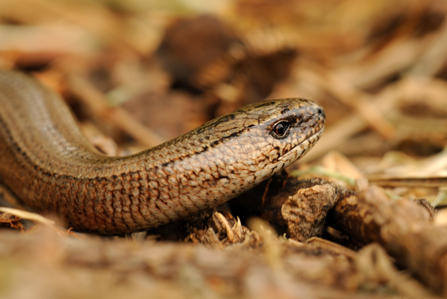
Slow worm by Amy Lewis
Grassland is a vital refuge for Suffolk's four species of reptile. And with common lizard, slow worm, grass snake and adder all under pressure from fragmentation of habitat, it's important that management techniques take their needs into consideration.
The following resources are designed to help you manage your grassland in a way that has low impact on reptiles, while also offering tips on how to improve their habitat.
Management of grassland to safeguard reptiles
When cutting rough or long grass it is important to take the possible presence of reptiles into account, to ensure they are not harmed. Reptiles are usually active between late March and the end of October, and the rest of the year they hibernate below ground, in banks or habitat piles.
Prior to mowing, walking through areas of long grass should disturb any creatures and encourage them temporarily to move elsewhere. It is important not to flatten the grass at it makes it difficult to cut.
Working slowly with machinery allows time for animals to escape. Slow worms and grass snakes are particularly sensitive to vibration and should move away quickly. However as these reptiles need to bask to become active they can be more sluggish when they first emerge (spring) , prior to hibernation in early autumn and early in the morning and evening.
Avoid cutting too low, as slow-worms will often move about in the basal zone of grasses and could be injured. If possible, cut on a warm day when reptiles will be active and therefore readily able to move out of the way. Allow temperatures to rise and reptiles to become active.
Work in a way that offers an escape route ie from middle outwards – so that animals do not become trapped by the mowing, as shown in the diagram.
Once cut, the resulting vegetation can be used to create habitat piles that will provide potential hibernation sites for creatures such as hedgehogs and grass snakes.
Creating habitat piles for reptiles
Wildlife rich areas should be avoided because the decomposition will add nutrients to the flower-rich sward, encouraging rank growth. Habitat piles should not be constructed where their decomposition may result in leachate entering water courses. Nor should they be stacked right up against tree trunks or against hedges. Ideally, the pile should be situated where it is in sun for part of the day and will not need to be disturbed.
Habitat piles need good aeration and good moisture content. Ideally the base of the heap should be criss-crossed with a layer of coarser material such as branches or logs, followed by material such as prunings and grass. This provides an internal structure to the heap, which makes it more attractive to reptiles. Habitat piles are used for basking and are particularly favoured by grass snakes for laying their eggs.
The same habitat pile can be replenished each year.
Legal protection
All Suffolk's reptiles have partial protection under the Wildlife and Countryside Act 1981, which means that they are protected against intentional killing and injuring and against sale or transporting for sale. All reptiles are Biodiversity Action Plan species, which means that they are a priority for conservation.
